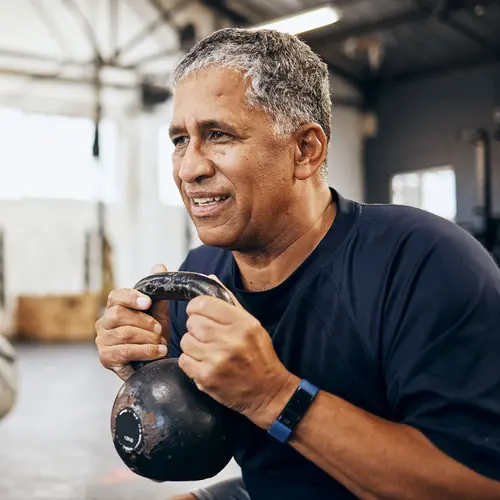How It Works
If you like your workouts mixed with adventure and adrenaline, then rock climbing may be the exercise for you.
Whether you’re climbing at an indoor rock gym or on real rock faces in the great outdoors, you’ll work muscles you never knew you had. And you’ll be surprised how fast you’ll break a sweat when you’re moving slow!
To be safe, you need to know what you're doing. So start by taking lessons at a rock climbing gym.
Intensity Level: High
You can't really do "rock climbing light." Even relatively easy routes require a whole-body effort and intense concentration. Super-tough routes will push you to the limit!
Areas It Targets
Core: Yes. Your core gives you the balance and strength you need to hold your body close to the wall.
Arms: Yes. Your forearms get a real workout from rock climbing, and your upper arms and shoulders pull you up when your legs can’t provide enough pushing force.
Legs: Yes. Proper climbing technique relies mostly on the legs for power.
Glutes: Yes. Rock climbing is a full-body workout, and you’ll need the power of your glutes, along with your leg muscles, to propel yourself upward.
Back: Yes. Muscles like your rhomboids, trapezius, and lats work with your core to keep you stable on the wall.
Type
Flexibility: Yes. You'll do a lot of reaching and stretching from one hold to the next.
Aerobic: Yes. Climbing can push your heart rate to between 120 and 180 beats per minute.
Strength: Yes.Rock climbing can push your strength to the limit.
Sport: Yes. Competitive climbing is growing in popularity, with teams all over the country. You can also climb just for fun!
Low-Impact: Yes. If you’re doing it right, your feet don’t even touch the ground.
What Else You Should Know
Cost: Expect to pay for time on a climbing wall at a rock gym, as well as renting equipment.
Good for beginners: Climbing requires a basic level of strength and fitness, so it’s probably not for you if you're not active now.
Outdoors: Yes. Most new climbers start out at indoor rock gyms, but there are many climbing sites outdoors.
At home: No. Although if you find you have a passion for climbing, a portable chin-up bar that you hang in your doorway can help you build up your strength.
Equipment required: Yes. You'll need at least climbing shoes and a harness, which you can rent at any rock gym. Climbing gyms usually provide other needed equipment, like ropes and carabiner clips. If you’re climbing outdoors, you’ll need to bring your own.
What Michael Smith, MD, Says:
Rock climbing is not for the faint of heart. But if you’re up for it, climbing will work you from head to toe, challenging you both mentally and physically.
Rock climbing can help you reach your peak fitness level and can mix things up to prevent workout boredom. Despite the intensity, climbing avoids the joint-jarring effects of high-impact activities like jogging and plyometrics.
That doesn’t mean it’s easy. Maintaining good control on the wall requires practically every muscle you have.
Of course, you need access to something to climb, and rock climbing hot spots are popping up in many areas.
If you’re not already in shape, it’s best to tone up a bit and get your heart used to pumping fast before you jump into climbing. But if you’re looking for an exhilarating workout and you’re up for some intensity, start climbing.
Is It Good for Me if I Have a Health Condition?
Rock climbing is an excellent workout, but it can be rough if your body isn’t up for it.
Weight loss helps many medical conditions, and rock climbing is an excellent way to drop a few pounds. If you have diabetes, high blood pressure, or high cholesterol, check with your doctor first and get the OK.
The aerobic workout and muscle building will help you burn more calories throughout the day. If you have diabetes, ask your doctor what to do in case your blood sugar goes too low during exercise.
Because of the demands that rock climbing puts on the body and the heart, rock climbing may be too tough for someone with heart disease. Look for another activity that your doctor recommends, and ask them if rock climbing may be a possibility down the road.
If you have a knee or back injury, rock climbing isn’t likely for you -- yet. Researchers are looking into whether rock climbing can help speed recovery from a knee injury. Until we know more, it’s better to hold off until you’re fully recovered. When you’re ready, work with an experienced climber who can give you pointers on how to keep it safe.
If you have arthritis, it may also be tough, since climbing can stress almost any joint in the body. Get your joints in better shape before climbing on the wall, and work with someone who can show you the ropes to help prevent further stress and pain.
If you have any other physical limitations, rock climbing may still be an option. Work with an instructor to see if it’s possible to adapt the activity to fit your needs.
Take caution if you’re pregnant. If you were an avid rock climber before getting pregnant, you can still take part if your doctor gives you the OK -- at least early in pregnancy. The main concern is the risk of falling. Later in pregnancy, the additional weight and your baby bump will make rock climbing increasingly difficult.


